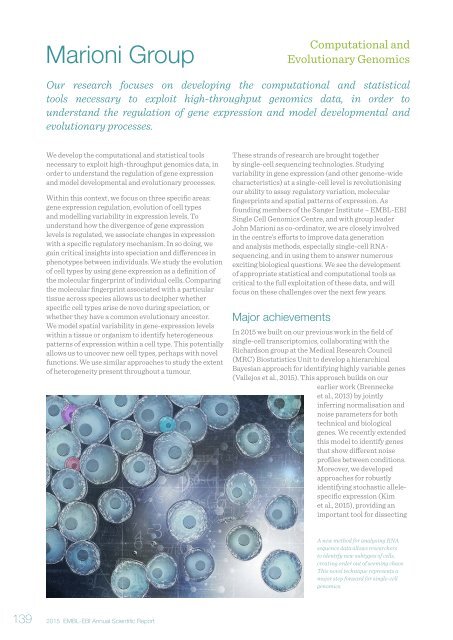Annual Scientific Report 2015
EMBL_EBI_ASR_2015_DigitalEdition
EMBL_EBI_ASR_2015_DigitalEdition
Create successful ePaper yourself
Turn your PDF publications into a flip-book with our unique Google optimized e-Paper software.
Marioni Group<br />
Computational and<br />
Evolutionary Genomics<br />
Our research focuses on developing the computational and statistical<br />
tools necessary to exploit high-throughput genomics data, in order to<br />
understand the regulation of gene expression and model developmental and<br />
evolutionary processes.<br />
We develop the computational and statistical tools<br />
necessary to exploit high-throughput genomics data, in<br />
order to understand the regulation of gene expression<br />
and model developmental and evolutionary processes.<br />
Within this context, we focus on three specific areas:<br />
gene expression regulation, evolution of cell types<br />
and modelling variability in expression levels. To<br />
understand how the divergence of gene expression<br />
levels is regulated, we associate changes in expression<br />
with a specific regulatory mechanism. In so doing, we<br />
gain critical insights into speciation and differences in<br />
phenotypes between individuals. We study the evolution<br />
of cell types by using gene expression as a definition of<br />
the molecular fingerprint of individual cells. Comparing<br />
the molecular fingerprint associated with a particular<br />
tissue across species allows us to decipher whether<br />
specific cell types arise de novo during speciation, or<br />
whether they have a common evolutionary ancestor.<br />
We model spatial variability in gene-expression levels<br />
within a tissue or organism to identify heterogeneous<br />
patterns of expression within a cell type. This potentially<br />
allows us to uncover new cell types, perhaps with novel<br />
functions. We use similar approaches to study the extent<br />
of heterogeneity present throughout a tumour.<br />
These strands of research are brought together<br />
by single-cell sequencing technologies. Studying<br />
variability in gene expression (and other genome-wide<br />
characteristics) at a single-cell level is revolutionising<br />
our ability to assay regulatory variation, molecular<br />
fingerprints and spatial patterns of expression. As<br />
founding members of the Sanger Institute – EMBL-EBI<br />
Single Cell Genomics Centre, and with group leader<br />
John Marioni as co-ordinator, we are closely involved<br />
in the centre’s efforts to improve data generation<br />
and analysis methods, especially single-cell RNAsequencing,<br />
and in using them to answer numerous<br />
exciting biological questions. We see the development<br />
of appropriate statistical and computational tools as<br />
critical to the full exploitation of these data, and will<br />
focus on these challenges over the next few years.<br />
Major achievements<br />
In <strong>2015</strong> we built on our previous work in the field of<br />
single-cell transcriptomics, collaborating with the<br />
Richardson group at the Medical Research Council<br />
(MRC) Biostatistics Unit to develop a hierarchical<br />
Bayesian approach for identifying highly variable genes<br />
(Vallejos et al., <strong>2015</strong>). This approach builds on our<br />
earlier work (Brennecke<br />
et al., 2013) by jointly<br />
inferring normalisation and<br />
noise parameters for both<br />
technical and biological<br />
genes. We recently extended<br />
this model to identify genes<br />
that show different noise<br />
profiles between conditions.<br />
Moreover, we developed<br />
approaches for robustly<br />
identifying stochastic allelespecific<br />
expression (Kim<br />
et al., <strong>2015</strong>), providing an<br />
important tool for dissecting<br />
A new method for analysing RNA<br />
sequence data allows researchers<br />
to identify new subtypes of cells,<br />
creating order out of seeming chaos<br />
This novel technique represents a<br />
major step forward for single-cell<br />
genomics.<br />
139<br />
<strong>2015</strong> EMBL-EBI <strong>Annual</strong> <strong>Scientific</strong> <strong>Report</strong>


